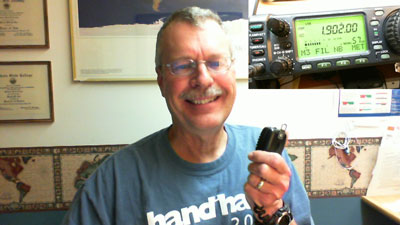
At this time of year I am always taken by surprise at how quickly the daylight hours fade every day here in the northern hemisphere. That means more hours of darkness and more HF radio fun in the evenings, as we mentioned last week when we extolled the virtues of 160, 80, and 40 m for long-distance communications. Things are also looking up in the daytime communications department, because my Windows sidebar gadget, "Full Sun 2.1" by John Stephen, shows me the face of the sun becoming more regularly dotted with sunspots. More sunspot activity means that the shorter wavelength HF bands like 10 and 15 meters will soon become much more reliable for very long distance daytime contacts.
If you have a Technician Class license, now is the time to consider an upgrade to General Class so that you can really use and appreciate all of these HF bands at a time when conditions favor some really great operating.
What makes me think about this upgrade business today of all days, when I am busy with your weekly E-letter and podcast is that tonight I will be teaching a two hour General Class course on rules and regulations. The course is open to anyone, but of course Technician Class license holders would probably be the most interested since they have already completed their first license and are familiar with ham radio terminology and operations, at least on the VHF and UHF bands. While some HF frequencies are open to Technician Class licensees, pretty much everyone realizes that an upgrade to General is a necessity if one is really going to enjoy shortwave operation.
One advantage that I feel that I have in teaching rules and regulations is that those who have passed the Technician are already familiar with the fact that we are regulated by the Federal Communications Commission and that the section of the rules governing the Amateur Radio Service are called Part 97. Anyone with a license should already know about frequency charts and about how the various levels of license allow for operation in different band segments. Everyone is already familiar with the fact that transmit power levels are regulated and that examinations are given by a VE team. Starting with this foundation of basic knowledge makes the General Class study regimen that much easier. I always start out the course by assuring my students that the examination for General Class will be 35 multiple-choice questions without any Morse code testing. Yes, I know that the code requirement has been gone for quite awhile now, but I still encounter students who either don't quite believe it or simply haven't gotten the news. One thing I have learned over years and years of teaching is that one cannot assume that the students know all of these basics on the first day of class!
Although I am very familiar with teaching into a microphone for our blind Handiham students, these courses taught in front of a class of students from the general public will only occasionally have a blind participant. This is going to sound a little bit odd, but I have to remind myself that I will now be expected to provide some visual learning cues as I speak and answer questions. For a traditional teacher of amateur radio at a typical radio club course the situation is reversed and that teacher may have considerable difficulty working with blind students. It all serves to remind me that the first time I meet my students I am going to have to assess them to find out how they learn and be flexible enough to adapt my teaching style accordingly. In teaching amateur radio courses, flexibility is the key. Your students will help guide you if you are open-minded enough to listen to them – just as we always tell new operators to listen on the bands before transmitting.
When I see a classroom full of students who are interested in amateur radio, I know that they are motivated to learn. After all, amateur radio classes are completely voluntary and these people could be doing something else instead of sitting in a ham radio class. This is a tremendous advantage and opportunity for me – and you – as teachers in amateur radio. Our students want to learn. We need to make sure that we are prepared to teach by having our teaching materials and any audiovisual equipment ready to go at the beginning of class so that we can move right into the topic at hand and make sure that we use the time as efficiently as possible.
Today we have the Internet and all of its amateur radio resources as study aids for post-class reinforcement of each week's classroom topic. Since I am teaching rules and regulations and the radio club has chosen the ARRL General Class License Manual as the official study guide, I will be referring my students to the section of the ARRL website that provides further information about that particular book, including extra study material, any corrections that might need to be made in the text, and – most importantly – a question pool organized to follow the book. Not everyone knows about this special question pool, so I never assume that my students have discovered it on their own. Believe me, it makes quite a difference to be able to follow the question pool in the same order as the chapters in your textbook. I also freely recommend other amateur radio websites that might help with either studying or practice examinations.
One disadvantage of having to teach the chapter about rules and regulations is that it is not considered a "fun" topic. When one thinks about rules and regulations, it brings to mind memorizing really dull legal-sounding rules and lots of frequency limits. I won't deny that there is some of that, but your job as an instructor is to help the students learn how to learn. That might mean pulling out the US Amateur Radio Bands frequency chart and helping the students to make sense of a page full of data that might otherwise seem overwhelming. One trick is to divide the frequency bands into the ones where there are no special General Class subsections and those that do have subsections. Breaking the frequency chart down in this manner can help your students remember which bands they may get questions on regarding frequency limits. Of course there is going to be some memory work no matter what you do in the classroom to help the students organize their thinking. I tell my students in no uncertain terms that they will have to sit down and do some memorization and that they will do it as homework. My volunteer instructors at Handiham Radio Camp have told me for years that studying at home is vital to ultimately passing the examination during the VE session at camp. Fortunately most radio club classes meet weekly for 8 to 10 weeks, giving your students much more time to study at home. Just be sure that they understand what to study and help them develop good study habits.
My classes are always interactive. I don't prefer to lecture from a podium for an hour and then have a question-and-answer session. Most people learn best if their questions are answered the instant they pop into their heads. If you wait to have a question and answer session you will find that many of your students have forgotten questions that might've come up during the lecture. A better way to conduct the class will be as a discussion that can be interrupted to answer questions. Time will be a factor, so a good teacher learns to manage this kind of interactive classroom experience in order to keep the class moving along while still allowing the students to participate actively during the entire class period.
Since my class is going to be in a two hour time frame, I am going to plan for a mid-class break. Your students will be more alert if they can attend to personal needs and walk around a bit instead of having to sit for an extended period of time.
Finally, when you are wrapping up your class, your students may feel overwhelmed with all of the material that you have managed to cram into the evening's session. Once they return home and think about what they have learned, which may even take the rest of the week, they may have other questions that they wish they had asked during the class. That's why I always provide my e-mail address and invite my students to ask questions whenever they think of them. My radio club teaches classes in Technician and General, offering the first license in the spring of the year in conjunction with an emergency weather spotter course. The upgrade class to General is offered in the autumn. All of the classes are taught by a team of volunteer instructors so that no one instructor will be tasked with many classes to prepare for over the course of 8 to 10 weeks.
I hope your radio club is offering classes as well. Over the years I have received the sad news from time to time that a radio club is dissolving and distributing its assets to worthy causes like the Handiham System. While I am always glad to receive support for our program, I really hate to see an amateur radio club closing its doors. I suspect that one of the biggest factors in the demise of these clubs was the absence of an education program to teach amateur radio classes. A club without an educational program is a club that is not building a base of new amateur radio operators in their community. This is a recipe for an aging club membership that will eventually diminish to a few members and eventually the plug will be pulled on the club. Don't let that happen to your club. Volunteer to help with an education program. If you have never been an amateur radio instructor, you may want to sit in on a class taught by one of your other club members or even a neighboring radio club's class. The idea is to learn how to teach and then get out there and do it. Rest assured that your efforts will be rewarded by the new members you will bring into the amateur radio community. You will have more members in your club, and these new members will have new ideas. Eventually they will become instructors themselves and they will also serve in leadership positions and provide new club programs. They will be the ones who will take up the mantle of "Elmers" who will be able to keep amateur radio healthy and growing into the future.
I always feel honored when I am asked to teach one of our classes. I hope you will feel that way, too.
I hope to hear you on the air soon.
73,
Patrick Tice, WA0TDA
Handiham Manager
wa0tda@arrl.net
A dip in the pool
No one told you there was going to be a quiz, right? I thought it would be fun to pick a question out of the question pool and see how many of us can remember the right answer. Ready? Here we go:
G1A01 [97.301(d)]
On which of the following bands is a General Class license holder granted all amateur
frequency privileges?A. 20, 17, and 12 meters
B. 160, 80, 40, and 10 meters
C. 160, 30, 17, 12, and 10 meters
D. 160, 30, 17, 15, 12, and 10 meters
Do see how sneaky I can be? In my opening remarks I specifically referred to teaching my students about dividing the frequency chart into bands where General Class licensees have full privileges and bands that have frequency restrictions. Think about which one of these is the correct answer and we will provide it at the end of this newsletter and podcast.

